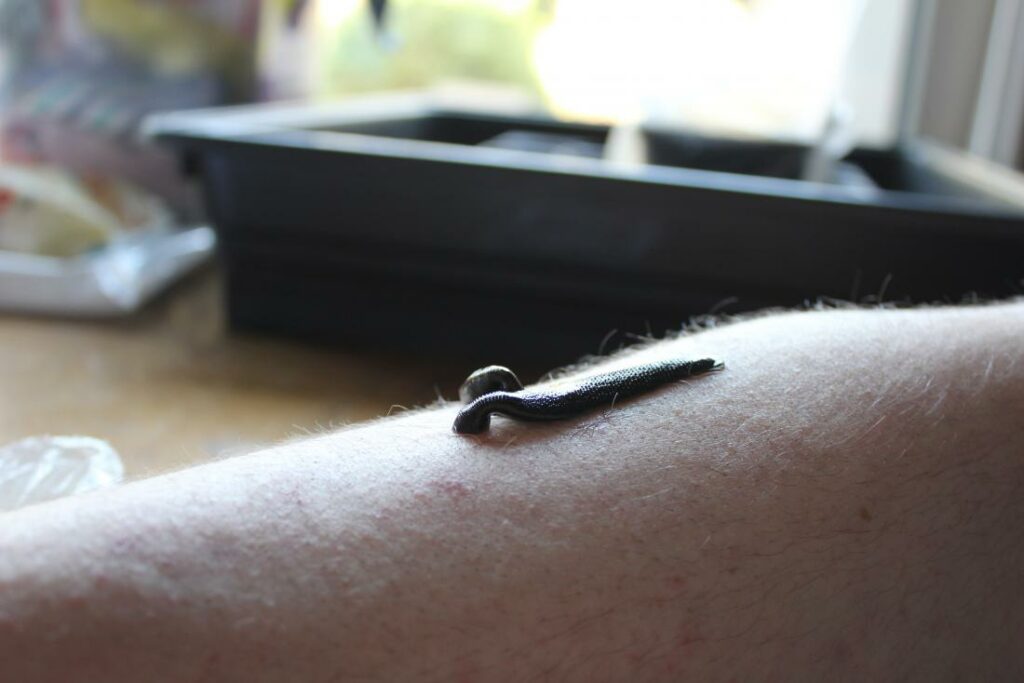In Ayurveda, Raktmokshana Karma (blood letting) is considered as a regimental therapy. The Ayurveda text Sushrut Samhita devoted a complete chapter on leech therapy. This therapy had a major setback due to origin and evolution of antibiotics. It is essential to adopt the procedure of leech therapy in autumn season for purification of body humors, which are otherwise deranged due to seasonal changes. Leech therapy is also indicated in the treatment of Raktaja Roga (diseases that are caused by or affecting the tissues of blood).

There are two types of Raktmokshana Karma described in Ayurveda. These are:
- Pracchana Karma (scarification or scrapping)
- Siravedha Karma (vein puncture)
In both of these procedures, sharp instruments are used and the amount of blood loss is more in Siravedha Karma than in Pracchana Karma.
There are alternative methods of blood letting for delicate patients. These are:
- Jaloka Avacharana (Medical Leech Therapy)
- Kshringa Avacharana (wet cupping)
- Alabu Avacharana (wet fire cupping)
The most delicate method of blood letting is Jaloka Avacharana (JA). Master Charak has considered JA as a surgical procedure.
JA has been used in various skin conditions such as kitibha (psoriasis), vicharchika (eczema), dadru (tinea infections), indralupta (alopecia areata), pakshaghata (hemiplegia), amavata (rheumatoid arthritis), vatarakta (osteoarthritis), shola (pain), sciatic nerve compression, vidradhi (pyogenic abscess), dushta-vrana (chronic wound), chronic ulcer, diabetic foot ulcer, venous ulcer and many other disorders.
JA in Ayurvedic treatment:
For JA, a thick paste of mustard seeds and turmeric was applied on jaloka (leech). Then, jaloka was suspended in solution of turmeric for approximately 45 minutes till they regained their motility.
- This jaloka was then applied on the desired spot for JA.
- On attachment to the desired spot, jaloka assumes the shape of a horse shoe in the raised and arched position. At this moment, jaloka was covered with white cotton and drops of cold water were frequently dropped on the covering part to provide cooling effect.
- Then, jaloka detaches itself after completing its feed. The efforts were made to regurgitate the ingested food.
- Subsiding of pain and disease were the signs of proper JA.
Probable mode of action of JA:
As per Ayurvedic texts, the probable mode of action of JA is due to its capacity of removing Rakt dhatu along with vitiated doshas. Rakta dhatu is the prime carrier of vitiated Pitta in the whole body. When Rakta dhatu is expelled from the body, it carries the vitiated Pitta with itself and thus purifying the body and further decreasing the quantum by compensatory production of healthy Rakta Dhatu.
Indications of JA in Ayurveda:
In Ayurveda, JA are indicated in delicate persons such as in weak patients, female patients, too old or too young patients suffering from blood related disorders. It is also indicated in:
- Tandra (unexplained mental fatigue)
- Gulma (various gastrointestinal disorders)
- Arsha, Vidardhi and Kustha (various skin disorders)
- Visha (poisoning)
- Kampa (tremors)
- Nidra atiyoga (excessive sleepiness)
- Visarpa (inflammatory skin conditions)
- Kandu (itching)
- Durbala (excessive weakness)
- Tikta amla udgara (belching with bitter and acidic taste)
- Sweda sharir durgandhya (excessive sweating with or without foul odour)
- Mada (unreasonable compulsive behaviour disorders)
Indications of MLT in biomedicine:
- Inflammatory conditions: MLT has beneficial effects as an adjuvant therapy in inflammatory conditions such as hypersensitivity conditions, rheumatic diseases such as rheumatoid arthritis, fibromyalgia, myasthenia gravis, gout, systemic lupus erythematosus (SLE), inflammatory diseases of internal organs etc.
- Cardiovascular disorders and Phlebology: It has benefits in diseases of cardiovascular origin such as acute, subacute and chronic thrombophlebitis, deep vein thrombosis, arterial hypertension, varicose veins, chronic venous insufficiency, ocular circulation disorders, peripheral circulation disorders, myocardial infarction and myocardial ischemia.
- In ophthalmological and ENT disorders: MLT has benefits in ENT disorders like tinnitus, peri-orbital haematomas, parotitis, acute and chronic otitis and in eye disorders such as glaucoma.
- In dentistry: Various studies have proved that MLT is useful in drainage of abscess from gums in root canal treatment, periodontitis and oral pemphigus.
- Other uses: It is useful in other disorders such as diseases of dermatological origin, diabetes and complications of diabetes mellitus, obesity, epilepsy, ovarian cysts and sterility in females, herpes zoster, male sterility, diseases of prostate gland and asthma.
The various indications and contraindications of Leech therapy can be clearly understood in present day terminology along with description in Ayurvedic texts.
Disclaimer:-
This article is not a substitute to the standard Medical Diagnosis or personalized Ayurvedic Treatment! It is intended only for Information!
For experts consultation, please write us at care@blessayurveda.com.
2,389 total views, 4 views today